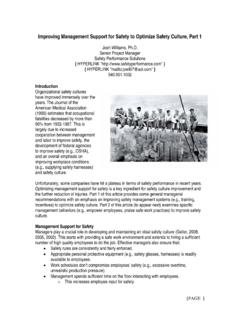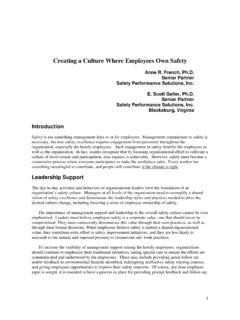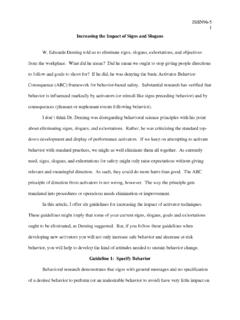Transcription of Increasing Employee Support for Safety - Safety …
1 Increasing Employee Engagement in Safety Organizations are increasingly seeking ways to increase Employee engagement for Safety to take them to the next level of Safety performance. To this end, the current article will address the development of innovative programs for Safety , the role of mentoring for newer employees, and the impact of Behavior-Based Safety (BBS) to increase Employee engagement for Safety . Specific BBS issues include: o Guidelines for implementing and optimizing BBS o Recommendations for following up on BBS data o Techniques to improve corrective and rewarding Safety feedback o Increasing key groups (managers, hourly etc.)
2 Support for BBS o Optimizing BBS participation {PAGE }Introduction The first step in Increasing Employee involvement for Safety is hiring conscientious employees who care about Safety . Unfortunately, some managers complain that their companies simply hire warm bodies or anyone who can pass the drug test. Others point out that selection practices are limited to brief interviews and a cursory resume examination. Organizations with elite employees normally offer competitive salaries and often use an array of selection tools, including cognitive (intelligence) tests, personality tests, biodata instruments, assessment center exercises, vocation tests (when appropriate) and/or structured interviews (Spector, 1996).
3 Structured interviews involve managers asking all prospective employees standardized questions during interviews which are behaviorally anchored and based on prior job analyses (Cascio, 1998). Once employees are in place, effective training and development is needed to cultivate and maintain desirable Employee behaviors and attitudes. This is especially true with Safety . Optimizing Safety culture requires active Employee engagement for Safety . It s imperative that employees provide each other corrective feedback when risky behavior is identified, especially since Safety shortcuts are often human nature ( , faster, easier) and because supervisors aren t always around.
4 This corrective feedback also sets the norm that safe behavior is expected. In weaker organizations, Safety shortcuts become the norm ( Forget about training, this is how we really do things around here. ) which gets passed down from generation to generation. To counter this, specific Safety efforts should target Safety culture improvement and hourly employees should be heavily involved in these efforts. This helps increase personal responsibility and Employee buy-in for Safety (Geller, 2005). Innovative Programs Increase Employee Involvement {PAGE }Leading organizations find creative ways to increase Employee involvement for Safety .
5 For example, one Virginia company used money they had budgeted to purchase Safety posters and gave it to select employees via a poster design contest. Specifically, the site shut down all operations for 2 hours and brought in all employees to create their own Safety posters. Prizes were given out for first ($100), second ($50) and third place ($25) as voted on by employees. Employees were given flip chart pages and markers/crayons to design their posters and were allowed to make as many posters as they wanted to for the contest. Employees really liked the idea.
6 In the end, the winning Employee was a maintenance worker who drew Forrest Gump running down the road wearing Safety glasses (and other PPE) under the caption, Safety IS as Safety DOES. Completed posters were hung up around the facility and were highly effective in getting employees attention. In another example, a company in West Virginia was struggling to increase Employee participation in filling out environmental audits and behavioral observation cards. Roughly 1 in 5 employees regularly filled out these cards. In response, the company decided to donate ten cents to the local Boys Club for all completed cards.
7 Within 6 months, the company had raised nearly $40,000 and participation rates had climbed to nearly 90%. Our experience has been that special programs focused on community service and family are highly effective in Increasing Employee involvement for Safety . Other organizations emphasize wellness programs to promote Employee health and Safety . One company in California conducts regular Safety fairs where employees go (with their families) to eat healthy food, receive back and foot massages, and get various health checks completed ( , blood pressure tests, cholesterol checks).
8 This organization also has a state-of-the-art gymnasium with incentives for employees to use it. They also pipe in new-age music every couple of hours. For 2-3 minutes, employees stop what they re doing and begin stretching (to combat fatigue and repetitive motion injuries). When the music stops, {PAGE }employees go back to work. In general, creative programs Safety programs can be used to facilitate Employee involvement in Safety . Mentoring In addition to innovative Safety programs, effective mentoring between highly experienced and highly inexperienced employees is extremely important to facilitate Employee engagement in Safety .
9 This is especially true when companies have large numbers of retiring employees who may (or may not) pass on their detailed, craft knowledge to new hires. Also, many companies don t backfill these positions which leaves remaining employees to do more work with less people. To formalize mentoring, one organization implemented a buddy for a week system. Essentially, an experienced Employee (with high job knowledge and a good attitude for Safety ) spent one week with a new hire working together, eating together etc. This process met with general acceptance from employees and helped to: pass on job specific knowledge, provide hands-on training, improve rapport between newer and older employees, and generally decrease the us vs.
10 Them mentality between groups. Behavioral Aspects of Injury Prevention Employee involvement for Safety can be increased through behavioral Safety efforts. Also, organizations are increasingly focusing on Safety behaviors to reduce injuries. In fact, most injuries are due, in part, to at-risk behaviors (Williams & Geller, 2000). In order to reduce injuries, it s important to understand why employees take shortcuts. Here are some fundamentals regarding employees Safety behaviors: It s usually faster, easier, and more comfortable to do things in a risky manner.















